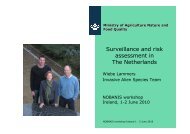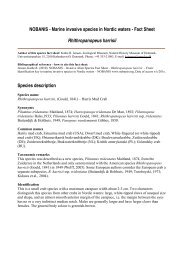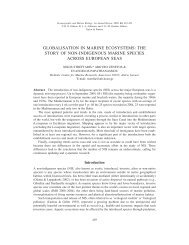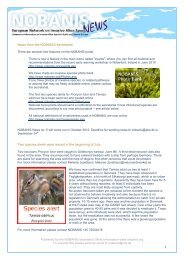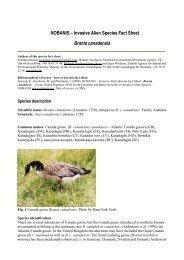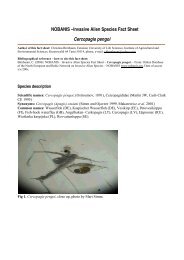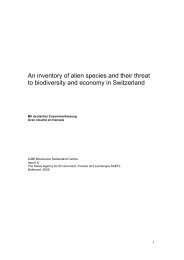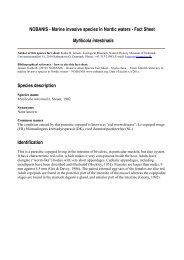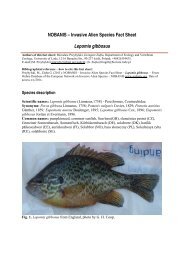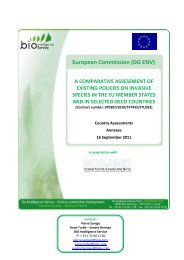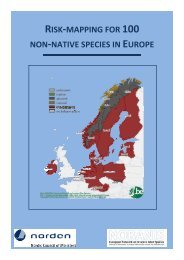NOBANIS – Invasive Alien Species Fact Sheet Heracleum sosnowskyi
NOBANIS – Invasive Alien Species Fact Sheet Heracleum sosnowskyi
NOBANIS – Invasive Alien Species Fact Sheet Heracleum sosnowskyi
You also want an ePaper? Increase the reach of your titles
YUMPU automatically turns print PDFs into web optimized ePapers that Google loves.
Reproduction and life cycle<br />
There are differing opinions about the life span of this species in Latvia. One opinion is that it is a<br />
biennial plant - in the first year it forms a large rosette and strong root system, in the second - great<br />
size and inflorescence with a considerable number of seeds. After fruiting the plant dies. Another<br />
opinion is that H. <strong>sosnowskyi</strong> is a perennial plant. Evidence supporting this opinion is the different<br />
rate of seed germination in the period of post-maturation, which can last 2 - 4 years. Another support<br />
for this view is the competition between the hogweeds in which some plants are not able to produce<br />
inflorescence 2 - 5 years after another. Therefore, seed production and life span lasts between 3 - 6<br />
years, sometimes even longer.<br />
Studies have been carried out in which the seedset was excluded by mowing before the inflorescence<br />
was formed. The results showed that in the second and following years the species was able to<br />
survive the winter and produce seeds and then die after flowering.<br />
Many practical workers consider that even when the mother plant dies, the off-root buds are able to<br />
produce shoots giving rise to new plants and in such a way become perennial plants. The new shoots<br />
of H. <strong>sosnowskyi</strong> are rather cold resistant and can survive -4 to -7 °C. It is found that starting from<br />
the second year they can survive down to -25 °C and under a snow cover even down to -45 °C. H.<br />
<strong>sosnowskyi</strong> is a light demanding plant and at the beginning of their growth they do not survive in<br />
shade (Oboļeviča 2001).<br />
Dispersal and spread<br />
Several main modes of seed dispersal are known, some are natural and some are human assisted. The<br />
description of seed dispersal is based on studies on H. mantegazzianum but the same of them applies<br />
to H. <strong>sosnowskyi</strong>. Populations often occur along streams and then water can spread seeds very<br />
efficiently, in large numbers and over considerable distances. Long-distance dispersal events that<br />
transport the seeds far from the source population are important mechanisms of plant dispersal, e.g.<br />
during extreme events such as floods. Wind is an important vector of local dispersal, especially in<br />
winter when seeds are blown over the frozen or snow-covered soil surface.<br />
H. <strong>sosnowskyi</strong> is also spread by various human activities. Roadside ditches and margins are among<br />
the most typical habitats and seeds may stick to tires of passing cars and can be spread far from the<br />
place where they were produced. Other mechanisms of seed dispersal by human activities are<br />
translocation of seeds with soil or dispersal of seeds attached to clothes or animal fur, e.g. sheep and<br />
cattle. If suitable sites are available, a high rate of spread is possible on both local and regional scales<br />
(Nielsen et al. 2005, Laiviņš and Gavrilova 2003). H. <strong>sosnowskyi</strong> is used as a decoration when dry<br />
which also perhaps contribute to the human-assisted dispersal of seeds.<br />
Impact<br />
Affected habitats and indigenous organisms<br />
H. <strong>sosnowskyi</strong> stands may range in extent from square metres to hectares, and small patches, linear<br />
stands or fringes can be found, e.g. along a streams, or scattered individuals. Even narrow stands<br />
may be conspicuous owing to the large stature of the species. The density of populations of hogweed<br />
may also vary considerably. In large stands, density may range from sparse growth (1-3 adult<br />
individuals/10 m 2 ) to covering almost the entire ground area (more than 20 adult individuals/10 m 2 )<br />
(Nielsen et al. 2005).<br />
8



